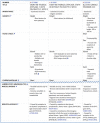OMIM.org: leveraging knowledge across phenotype-gene relationships
- PMID: 30445645
- PMCID: PMC6323937
- DOI: 10.1093/nar/gky1151
OMIM.org: leveraging knowledge across phenotype-gene relationships
Abstract
For over 50 years Mendelian Inheritance in Man has chronicled the collective knowledge of the field of medical genetics. It initially cataloged the known X-linked, autosomal recessive and autosomal dominant inherited disorders, but grew to be the primary repository of curated information on both genes and genetic phenotypes and the relationships between them. Each phenotype and gene is given a separate entry assigned a stable, unique identifier. The entries contain structured summaries of new and important information based on expert review of the biomedical literature. OMIM.org provides interactive access to the knowledge repository, including genomic coordinate searches of the gene map, views of genetic heterogeneity of phenotypes in Phenotypic Series, and side-by-side comparisons of clinical synopses. OMIM.org also supports computational queries via a robust API. All entries have extensive targeted links to other genomic resources and additional references. Updates to OMIM can be found on the update list or followed through the MIMmatch service. Updated user guides and tutorials are available on the website. As of September 2018, OMIM had over 24,600 entries, and the OMIM Morbid Map Scorecard had 6,259 molecularized phenotypes connected to 3,961 genes.
Figures



References
-
- McKusick V.A. Mendelian Inheritance in Man: A Catalog of Human Genes and Genetic Disorders. 1998; 12th ednBaltimore: Johns Hopkins University Press.
Publication types
MeSH terms
Grants and funding
LinkOut - more resources
Full Text Sources
Other Literature Sources
Molecular Biology Databases
Research Materials

